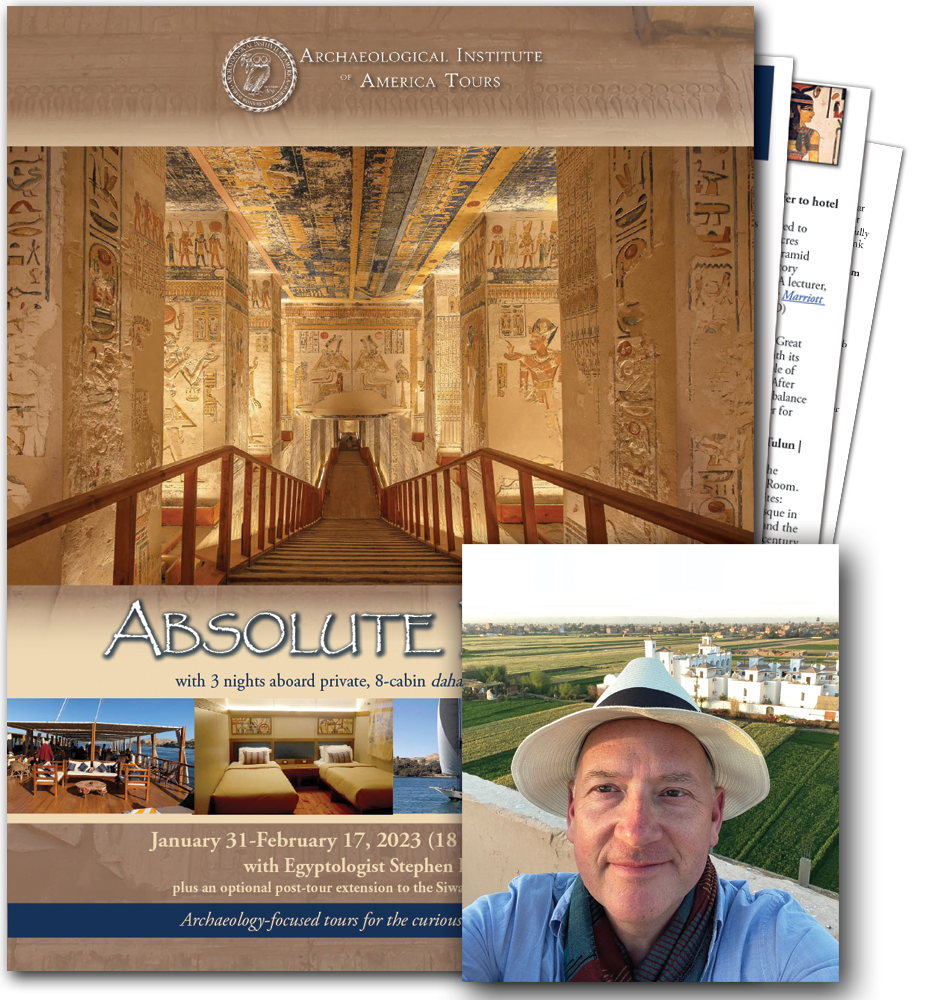This tour is in the planning stages for a January/February departure in 2025. For more information and to be notified with the brochure is ready. Please contact us at 800-748-6262 or aia@studytours.org.
This itinerary is carefully crafted to provide discerning travelers with the finest Egypt tour available. Our 18-day program is the most in-depth exploration of ancient Egypt’s greatest sites, combining all the best attributes of a small-group, all-inclusive, well-paced, luxury trip.
“Our Absolute Egypt tour was outstanding! The tour team…brought ancient Egypt to life. Their knowledge,enthusiasm, hard work and fun spirit brought the joy of learning each day of the trip.”
– Dale, Washington
Highlights:
- Learn with a distinguished and engaging American scholar plus a wonderful local Egyptologist and an excellent tour manager. This trio has been receiving accolades for many years.
- Travel with a maximum of just 16 guests plus your trio of leaders.
- Enjoy the best accommodations, including 13 nights at luxurious, 5-star hotels in Giza, Cairo, Luxor, and Aswan; and a three-night Nile cruise aboard a comfortable, eight-cabin dahabiya (traditional Nile sail boat).
- Meet with excavators and conservators, including behind-the-scenes visits,
- when possible.
- Discover the preeminent sites of the pharaohs from Cairo to Luxor, Aswan, and Abu Simbel:
- If it is open, spend two full days exploring the Grand Egyptian Museum that is scheduled to open in 2023.
- See the amazing Giza pyramids and Sphinx as well as Saqqara’s Step Pyramid of Djoser and recently discovered, closed-to-the-public, Tomb of Wah Ti.
- Explore the astounding temple complex of Karnak as well as Luxor Temple, plus spectacular royal mortuary temples and tombs in the Valleys of the Kings and Queens, such as those of Seti I and Nefertari.
- Visit the remarkable Temple of Hathor at Dendara as well as Abydos, one of the oldest and most important cities in ancient Egypt, where Steve Harvey, your AIA lecturer, has been working since 1993.
- Cruise the Nile from Esna to Aswan aboard an eight-cabin sail boat, away from the convoys of large riverboats, so that we visit remarkable temples without the typical crowds. From the spacious top deck, observe timeless pastoral scenes of feluccas, farmers, herders, and village life.
- Fly to Abu Simbel to visit the stunning and enormous rock-cut temples of Ramesses II and Nefertari.
- An optional, eight-day, post-tour extension to Jordan is available.
In short, this is the most exclusive, enjoyable, and fascinating introduction to Egypt available. It is limited to just 16 guests, so I urge you to reserve your space today.
Main Tour Pricing per person (16 nights):
TBA
With fewer than 9 participants, a small group surcharge may be added.
Single room supplement will be charged when requested or required (limited availability)..
To request a brochure when it is complete, click here.
For advance information or questions, please email us at aia@studytours.org (and include your full name) or call us toll-free at (800) 748-6262 (toll: 603-756-2884). To reserve your space using the online form, click here.
